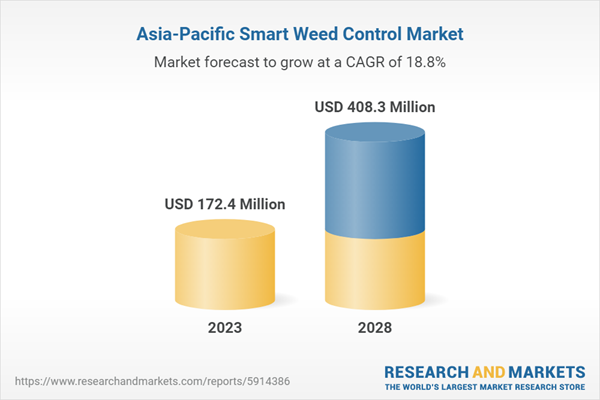10% Free customization
The Asia-Pacific smart weed control market (excluding China), valued at $135.7 million in 2022, is expected to reach $408.3 million by 2028, exhibiting a robust CAGR of 18.8% during the forecast period (2023-2028). The agriculture industry's expanding emphasis on increasing crop yields while lowering input costs is the main factor driving the rise. Effective weed control, efficient herbicide application, and accurate and targeted weed management are all made possible by smart weed control technologies. These technologies are expected to boost the growth of the global smart weed control market in the upcoming years by helping farmers make data-driven decisions, improve operational efficiency, cut down on resource waste, and lessen their environmental impact. This report comes with 10% free customization, enabling you to add data that meets your specific business needs.
Market Introduction
Smart weed control effectively detects and removes undesired plants by utilizing cutting-edge technology including robots, computer vision, and machine learning. These systems reduce the need for chemical pesticides and manual work by focusing on weeds while minimizing their influence on desired crops through analysis of plant features and growth patterns. Together, sensors, AI-driven equipment, and autonomous drones accurately apply treatment, maximizing resource efficiency and advancing sustainable agriculture. This cutting-edge method ensures effective and environmentally responsible crop production by increasing output, reducing harm to the environment, and revolutionizing weed management for modern farming.As a result, smart weed control is becoming more and more important in contemporary agriculture since it has the ability to transform weed management techniques and solve important issues that land managers and farmers face. Smart weed control aims to get around the drawbacks of traditional weed control techniques like hand weeding and indiscriminate pesticide spraying. Sustainability of the environment is one of the main justifications for the need for intelligent weed management. The spraying of conventional herbicides may result in chemical drift, which could harm non-target plants and have an adverse effect on wildlife. Conversely, smart weed management minimizes chemical use and lowers the possibility of environmental contamination by providing focused and accurate herbicide application.
Market Segmentation:
Segmentation 1: by Application
- Agriculture
- Non-Agriculture
Segmentation 2: by Type
- Weed Mapping
- Weed Sensing and Management
Segmentation 3: by Region
- China
- Asia-Pacific - Japan, India, Australia and New Zealand, South Korea, and Rest-of-Asia-Pacific
How can this report add value to an organization?
Product/Innovation Strategy: The product segment helps the reader to understand the different technologies used for smart weed control and their potential in Asia-Pacific region. Moreover, the study gives the reader a detailed understanding of the different solutions provided by smart weed control providers for imaging, processing, and analyzing. Compared to conventional agricultural methods, smart weed control enables more exact targeting of planting, soil mapping, and forestry, allowing farmers to save money by maximizing the use of their inputs.Growth/Marketing Strategy: The Asia-Pacific smart weed control market has seen major development by key players operating in the market, such as business expansion, partnership, collaboration, and joint venture. The favored strategy for the companies has been partnership, collaboration, and joint venture activities to strengthen their position in the Asia-Pacific smart weed control market.
Competitive Strategy: Key players in the smart weed control market analyzed and profiled in the study involve smart weed control-based product manufacturers, including market segments covered by distinct product kinds, applications served, and regional presence, as well as the influence of important market tactics employed. Moreover, a detailed competitive benchmarking of the players operating in the Asia-Pacific smart weed control market has been done to help the reader understand how players stack against each other, presenting a clear market landscape. Additionally, comprehensive competitive strategies such as partnerships, agreements, and collaborations will aid the reader in understanding the untapped revenue pockets in the market.
This product will be delivered within 3-5 business days.
Table of Contents
1 Markets
2 Region
3 Markets - Competitive Benchmarking and Company Profiles
4 Research Methodology
List of Figures
List of Tables
Executive Summary
The Asia-Pacific smart weed control market (excluding China) is estimated to reach $408.3 million by 2028, reveals the premium market intelligence study. The study also highlights that the market is set to witness a CAGR of 18.8% during the forecast period 2023-2028.The Asia-Pacific Smart Weed Control Market: Drivers and Challenges
With a growing population and increasing food demand, maximizing crop yields is vital to ensure food security. Smart weed management technologies, such as precision application and data-driven decision-making, enable farmers to optimize herbicide use, reduce waste, and enhance overall crop productivity. In addition, the region is experiencing the highest growth rates in various technologies.The Asia-Pacific region is very cost-sensitive, especially countries such as India, Malaysia, Indonesia, the Philippines, and other South Asian countries, due to which the smart weed control market has a lower adoption rate compared to developed nations. This is acting as a huge challenge for the region.
USPs of report
- Analysis of business drivers and challenges of the Asia-Pacific Smart Weed Control Market
- Detailed analysis of Smart Weed Control Market for Japan, South Korea and India
Market segregation based on type and application
Analyst’s Perspective on Smart Weed Control Market
The Principal Analyst states, 'The smart weed control market has been experiencing significant growth in recent years. With advancements in sensor technology, artificial intelligence, and precision agriculture, farmers now have access to innovative solutions for optimizing herbicide applications and smart weed management. These technologies enable targeted and site-specific weed control, reducing herbicide usage and minimizing environmental impact while increasing overall efficiency.'Key Companies in Asia-Pacific
- SprayingDrone Inc
- Deere & Company
- AGCO Corporation
- One Smart Spray
- XAG Co., Ltd.
- DJI
- SenseFly
Key Questions Answered in the Report
- What are the major market drivers, challenges, and opportunities in the Asia-Pacific smart weed control market?
- What is the expected smart weed control market size in terms of value during the period 2023-2028?
- What is the expected future scenario and revenue generated by different application segments in the smart weed control market, including agriculture and non-agriculture applications?
Companies Mentioned
- Robotic Weeder Companies
- Drone or UAV Sprayer Companies
- XAG Co., Ltd.
Table Information
| Report Attribute | Details |
|---|---|
| No. of Pages | 103 |
| Published | December 2023 |
| Forecast Period | 2023 - 2028 |
| Estimated Market Value ( USD | $ 172.4 Million |
| Forecasted Market Value ( USD | $ 408.3 Million |
| Compound Annual Growth Rate | 18.8% |
| Regions Covered | Asia Pacific |
| No. of Companies Mentioned | 3 |









